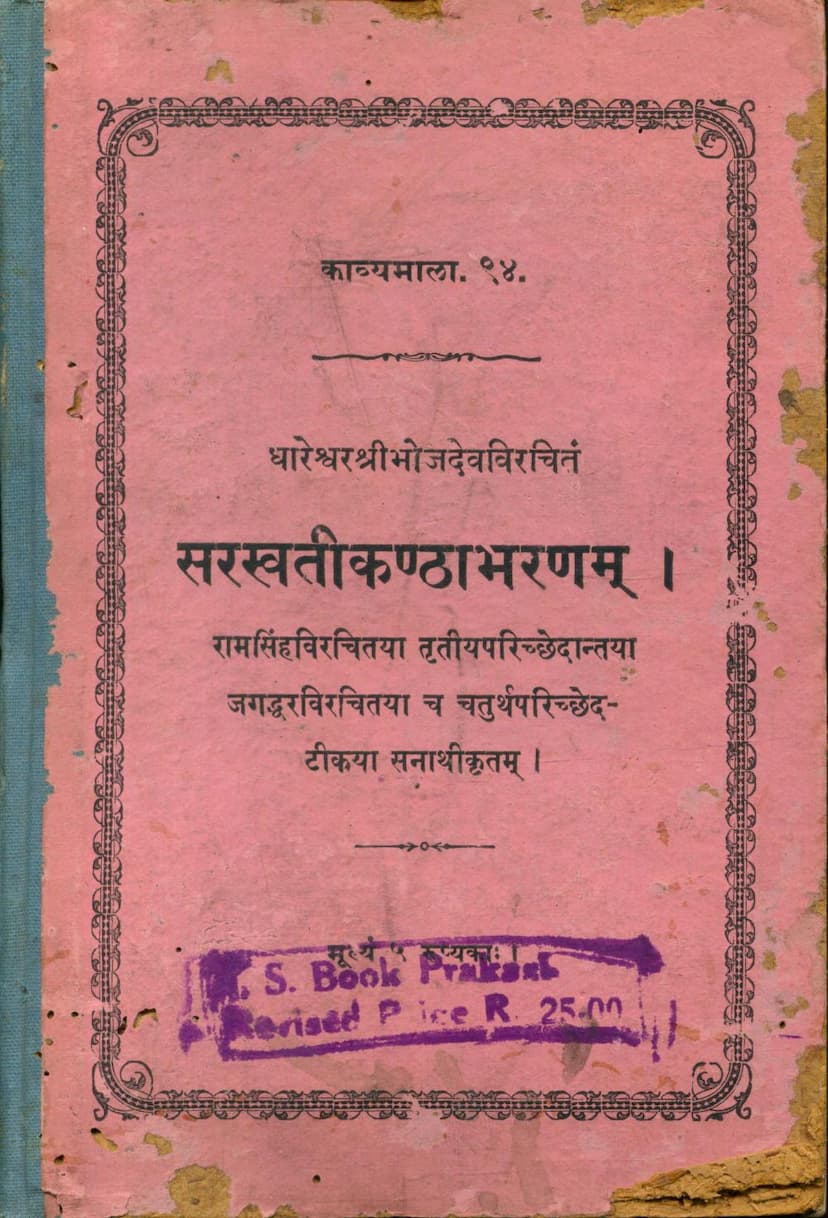Sarasvatikanthabharanam
Added to library: September 2, 2025

Summary
Sarasvatikanthabharanam: A Comprehensive Summary
The provided text is a detailed catalog and introduction to Sarasvatikanthabharanam, a seminal work on Sanskrit poetics (Alankara Shastra) authored by Dhareshvara Bhojdev. This edition, published by Pandurang Jawaji in Bombay in 1934, is the second edition and includes commentaries by Ramsinha for the first three chapters and Jagaddhara for the fourth chapter. It was meticulously revised by Pandit Kedarnath Sharma and Vasudev Laxman Shastri Pansikar.
The work is a highly respected treatise on Sanskrit grammar, rhetoric, and literary criticism, aiming to adorn (abharanam) Sarasvati, the goddess of speech and learning. While the provided text focuses on the catalogue and introduction, it offers substantial insight into the scope and nature of the Sarasvatikanthabharanam itself.
Key Aspects Highlighted in the Text:
-
Authoritative Authorship: The text strongly emphasizes the authorship of Bhojdev, linking him to the Paramara dynasty and identifying him as a renowned king and patron of arts and literature. His reign is estimated to be from 1010 to 1055 AD.
-
Comprehensive Coverage of Poetics: The catalog section (pages 34 onwards) reveals an extraordinarily detailed table of contents. The work is systematically divided into six chapters (Parichheda), covering:
- Chapter 1: Doshavivichanam (Analysis of Defects): This chapter delves into various defects in poetry, meticulously categorizing them based on words (Pada Dosha), sentences (Vakya Dosha), and sentence meanings (Vakyartha Dosha). It lists sixteen defects for each category, providing detailed explanations and examples.
- Chapter 2: Alankaranirnayam (Determination of Figures of Speech - Shabda Alankaras): This chapter focuses on figures of speech related to sound and language (Shabda Alankaras). It outlines their classification based on language (Sanskrita, Prakrita, etc.), the nature of the speech (jati), and external/internal qualities. It enumerates various figures like Anupras (alliteration), Yamaka (rhyme), Slesha (pun), and others, with extensive examples and explanations.
- Chapter 3: Arthalamkaravivachanam (Analysis of Figures of Speech - Artha Alankaras): This chapter systematically analyzes figures of speech based on meaning (Artha Alankaras). It begins with Upama (simile) and its various forms, followed by Rupaka (metaphor), Samasokti (personification/metonymy), Utpreksha (hyperbole/fancy), and a multitude of other figures of speech, each with detailed descriptions and illustrative examples.
- Chapter 4: Ubbhayalamkara-vivechananam (Analysis of Figures of Speech - Ubhaya Alankaras): This chapter addresses figures of speech that involve both sound and meaning. It lists twenty-four such figures, including various forms of Upama and Rupaka, and their subdivisions.
- Chapter 5: Rasavivichanam (Analysis of Rasas/Emotions): This chapter is dedicated to the concept of Rasa, the aesthetic sentiment or emotional essence evoked by poetry. It meticulously categorizes and defines the primary Rasas (like Shringara - love, Veera - heroism, Karuna - pathos, etc.), their constituent emotions (Bhava), their manifestations (Anubhava), and their causes (Vibhava). It also discusses secondary emotions (Vyabhichari Bhava) and their role in shaping the overall aesthetic experience.
- Chapter 6: (Implied) Upasamhara/Mangalacharanam: While not explicitly detailed in the provided catalog, the structure suggests a concluding section possibly encompassing concluding remarks, benedictions, or indices.
-
Extensive Citations: The catalog highlights the vast network of literary sources cited within the Sarasvatikanthabharanam. It lists numerous poets and their works, including Kalidasa (Raghuvamsha, Kumarasambhava, Meghaduta, Shakuntala, Vikramorvashiya), Bana (Kadambari, Chandi Shataka), Dandi (Kavyadarsha, Dashakumaracharita, Chhandovichiti), Bhavabhuti (Uttaramacharita, Mahaviracharita, Malatimadhava), Bharavi (Kiratarjuniya), Magha (Shishupalavadha), and many others. This demonstrates Bhojdev's profound knowledge of existing literature and his rigorous analytical approach.
-
Historical Context and Bhojdev's Life: The introduction provides significant biographical and historical context regarding Bhojdev. It discusses his lineage, his reign, his patronage of scholars, and even offers insights into potential political and personal events that might have influenced his work. The text also acknowledges the efforts of the editors and publishers in bringing this significant work to the public.
-
Commentaries: The presence of commentaries by Ramsinha and Jagaddhara is crucial, indicating the text's importance and the need for further elucidation for readers to fully grasp its nuances.
-
Literary Merit: The text implicitly and explicitly praises Sarasvatikanthabharanam as a masterpiece that adorns Sarasvati. The detailed categorization of poetic elements suggests a highly structured and analytical approach to literature.
Overall Significance:
Sarasvatikanthabharanam is a monumental contribution to Sanskrit literary theory. It provides a comprehensive framework for understanding the mechanics and artistry of Sanskrit poetry. Its meticulous classification, extensive citations, and profound analysis make it an indispensable resource for scholars and students of Sanskrit literature and linguistics. The provided text, being an introduction to a respected edition, underscores the enduring relevance and scholarly value of this ancient work. It serves as a testament to the intellectual richness of Indian literary traditions.